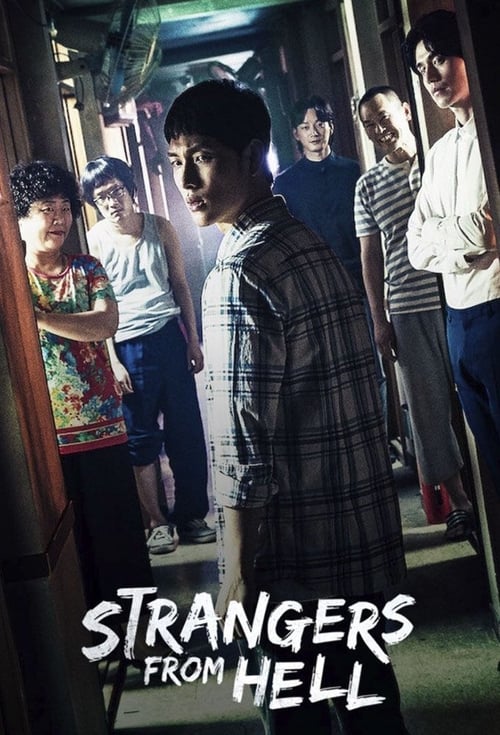
Ask Your Own Question
What is the plot?
The episode begins with a flashback to 2000, where a young girl named Lee Jae-hyun is seen playing in a park. She is approached by a man who offers her candy. The scene quickly shifts to the present day, where Detective Park Hae-young is investigating a series of murders that have been linked to the same suspect over the years. He is haunted by the unsolved case of the young girl from the flashback, which drives his determination to find the killer.
Park Hae-young receives a call from his partner, Detective Kim Hyeon-joon, who informs him that they have found a new lead in the case. They head to the police station, where they meet with forensic experts who have analyzed evidence from the latest crime scene. The team discusses the similarities between the current case and the past murders, particularly focusing on the modus operandi of the killer. Tension builds as they realize that the killer has been active for years, evading capture.
Meanwhile, the episode cuts to a scene where a young woman, who is a potential witness, is being questioned by the police. She describes a man she saw near the crime scene, providing a detailed description that matches the profile of the suspect. The detectives take her statement seriously, and they begin to piece together a timeline of the suspect's movements. Park Hae-young feels a sense of urgency as he realizes that they may finally be close to identifying the killer.
As the investigation progresses, Park Hae-young receives a mysterious phone call from a man claiming to have information about the case. The caller is revealed to be a former detective who worked on the original case. He shares crucial details that were never made public, including the fact that the killer had a specific pattern and that he may have been targeting victims who resembled the young girl from the flashback. This revelation deepens Park Hae-young's obsession with the case, as he feels a personal connection to the victims.
The detectives decide to revisit the original crime scenes to gather more evidence. They split up, with Park Hae-young and Kim Hyeon-joon going to the park where the young girl was last seen. As they search the area, they discover a hidden piece of evidence that had been overlooked: a small toy that belonged to the girl. This discovery reignites their determination to solve the case, and they begin to theorize about the killer's motives.
In a pivotal moment, Park Hae-young confronts his superior about the lack of progress in the investigation. He argues passionately for more resources and support, emphasizing the importance of catching the killer before he strikes again. His superior is initially dismissive, but Park Hae-young's fervor convinces him to allocate additional manpower to the case.
The episode takes a dramatic turn when the detectives receive a tip-off about a potential suspect. They track him down to a rundown apartment building. As they approach the suspect's door, tension mounts. Park Hae-young and Kim Hyeon-joon prepare to make an arrest, but the suspect becomes agitated and attempts to flee. A chase ensues through the building, with the detectives navigating narrow hallways and staircases.
During the chase, Park Hae-young's determination is palpable as he pushes himself to catch the suspect. He finally corners him in an alleyway, where a physical confrontation breaks out. The suspect fights back, and the two engage in a struggle. Park Hae-young manages to subdue him, but not without sustaining injuries. The emotional weight of the moment is heavy as he realizes that they may have finally caught the man responsible for the murders.
After the arrest, the detectives bring the suspect in for questioning. As they interrogate him, he initially denies any involvement in the crimes. However, under pressure, he begins to crack, revealing details that only the killer would know. The detectives feel a mix of triumph and relief as they realize they are on the verge of solving the case.
The episode concludes with a somber reflection on the impact of the case on the victims' families. Park Hae-young stands alone, contemplating the emotional toll of the investigation. He is determined to see the case through to the end, knowing that justice must be served for the victims and their loved ones. The screen fades to black, leaving the audience with a sense of anticipation for what will come next in the ongoing investigation.
What is the ending?
In the ending of "We Found the Killer," the team successfully identifies the murderer of a series of crimes, but the resolution comes with a heavy emotional toll. The episode concludes with the characters grappling with the consequences of their actions and the unresolved pain from the past.
As the episode unfolds, we see the aftermath of the investigation. The main characters, Detective Park Hae-young, Detective Lee Jae-han, and the forensic expert, Kim Hye-soo, are deeply affected by the revelations they have uncovered. They confront the reality of the killer's identity and the impact it has on the victims' families. The emotional weight of their discoveries hangs heavily in the air, as they reflect on the lives lost and the justice that has been delayed for so long.
In the final scenes, Detective Park Hae-young is shown in a moment of quiet contemplation, wrestling with the moral implications of their findings. He feels a mix of relief and sorrow, knowing that they have brought closure to some families, but also recognizing the scars that remain. Detective Lee Jae-han, who has been a guiding force throughout the investigation, shares a poignant moment with Hye-soo, acknowledging the toll that their work has taken on them personally. The episode closes with a sense of unresolved tension, as the characters are left to ponder the complexities of justice and the lingering shadows of their past.
As the camera pulls away, we see the three of them standing together, united in their shared experience, yet each carrying their own burdens. The screen fades to black, leaving the audience with a lingering sense of both hope and melancholy.
In the final act of "We Found the Killer," the tension escalates as the detectives close in on the identity of the murderer. The episode begins with Detective Park Hae-young receiving a crucial piece of evidence that links a suspect to the series of murders they have been investigating. This moment ignites a renewed sense of urgency within the team, as they realize they are on the brink of solving a case that has haunted them for years.
Scene by scene, the investigation unfolds with meticulous detail. Detective Lee Jae-han, who has been working tirelessly alongside Hae-young, expresses his determination to bring justice to the victims. His dedication is palpable, and the audience can feel the weight of his commitment as he pushes the team to follow every lead. Meanwhile, Kim Hye-soo, the forensic expert, meticulously analyzes the evidence, her brow furrowed in concentration. She is driven not only by her professional duty but also by a personal connection to the victims, which adds an emotional layer to her character.
As they gather more evidence, the detectives confront the suspect, leading to a tense interrogation scene. The atmosphere is thick with suspense as they piece together the timeline of events, revealing the chilling motivations behind the murders. The suspect's demeanor shifts from arrogance to desperation, and the detectives leverage this change to extract a confession. The moment is fraught with emotion, as the characters grapple with the reality of what they are uncovering.
Once the confession is obtained, the team reflects on the implications of their findings. They visit the families of the victims, delivering the news with a mix of compassion and sorrow. Each interaction is laden with emotional weight, as the families react with a blend of relief and grief. The detectives are visibly affected by these encounters, their faces etched with empathy and the burden of their roles in the justice system.
In the closing moments, the characters gather in a quiet space, allowing the gravity of their work to settle in. Detective Park Hae-young stands apart for a moment, lost in thought. He contemplates the lives that have been irrevocably changed by the actions of the killer and the justice they have fought to achieve. Detective Lee Jae-han approaches him, and they share a moment of understanding, acknowledging the emotional toll their work has taken on them.
Kim Hye-soo joins them, and the three of them stand together, united in their shared experience yet individually carrying the weight of their memories. The camera captures their expressions, revealing a mix of relief, sorrow, and a lingering sense of unresolved tension. As the scene fades, the audience is left with the poignant reminder of the complexities of justice and the emotional scars that remain long after the case is closed.
The episode concludes with a sense of hope intertwined with melancholy, as the characters are left to navigate their own paths forward, forever changed by the events they have witnessed. The screen fades to black, leaving viewers to reflect on the intricate web of human emotions and the quest for justice that defines their journey.
Is there a post-credit scene?
In "We Found the Killer," the fourth episode of Signal, there is no post-credit scene. The episode concludes without any additional scenes after the credits roll. The focus remains on the main narrative and character developments throughout the episode, leaving no extra content for viewers to engage with after the main story has ended.
What evidence leads the team to believe they have found the killer in this episode?
In this episode, the team discovers a crucial piece of evidence: a fingerprint found on a victim's belongings that matches a suspect from a previous case. This fingerprint becomes the focal point of their investigation, leading them to delve deeper into the suspect's background and connections.
How does the communication between the two timelines impact the investigation in this episode?
The communication between the two timelines is pivotal in this episode as it allows the characters to share critical information about the case. Detective Park Hae-young receives insights from the past that help him piece together the timeline of events, ultimately guiding the team to the suspect.
What role does the character of Detective Lee Jae-han play in the investigation during this episode?
Detective Lee Jae-han plays a crucial role as he provides historical context and details from the past that are essential for understanding the current case. His insights help bridge the gap between the two timelines, allowing the team to connect the dots and move closer to identifying the killer.
How does the emotional state of Detective Park Hae-young evolve throughout this episode?
Throughout the episode, Detective Park Hae-young experiences a range of emotions, from determination to frustration. As he uncovers more evidence and faces setbacks, his resolve strengthens, but he also grapples with the weight of the past and the pressure to solve the case, leading to moments of vulnerability.
What specific challenges do the characters face in gathering evidence against the suspect?
The characters face several challenges in gathering evidence against the suspect, including the lack of physical evidence linking him directly to the crime scene and the need to navigate bureaucratic obstacles within the police department. Additionally, they must contend with the emotional toll of revisiting traumatic events from the past.
Is this family friendly?
In "We Found the Killer," the fourth episode of Signal, there are several elements that may be considered objectionable or upsetting for children or sensitive viewers:
-
Violence and Crime: The episode revolves around a murder case, which includes discussions of violent acts and the investigation into a killer. There are scenes depicting the aftermath of crime, which may be disturbing.
-
Emotional Trauma: Characters experience significant emotional distress related to the murder case, including grief and fear. This may be intense for younger viewers.
-
Police Procedures: The portrayal of police investigations includes discussions of evidence collection and interrogation, which may be unsettling for some.
-
Dark Themes: The overall theme of the episode deals with crime and the impact of violence on families, which can be heavy and potentially upsetting.
These elements contribute to a tone that may not be suitable for all audiences, particularly younger children or those sensitive to themes of violence and emotional trauma.































